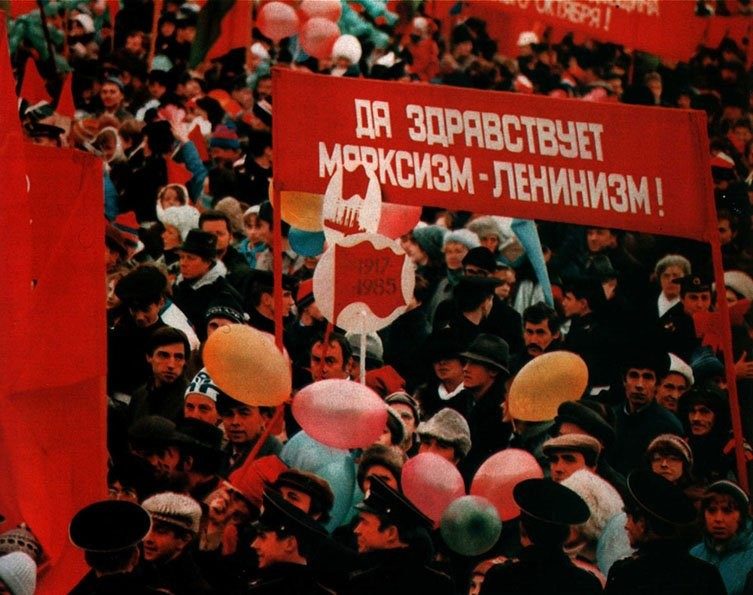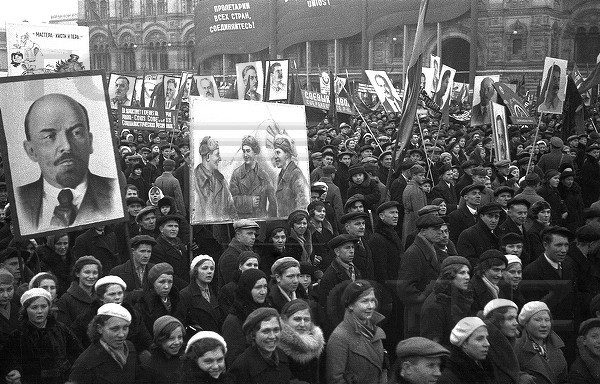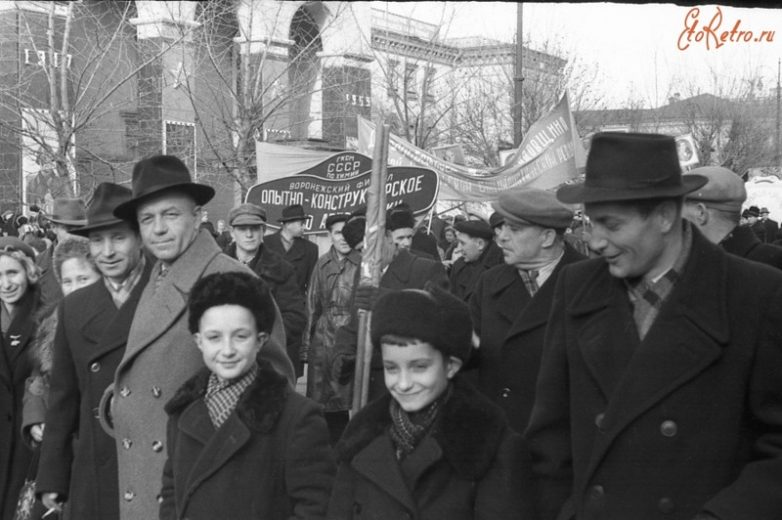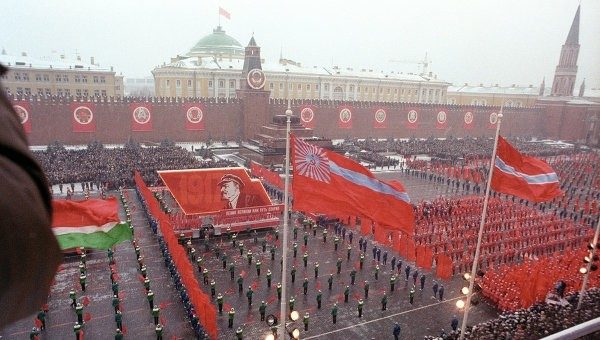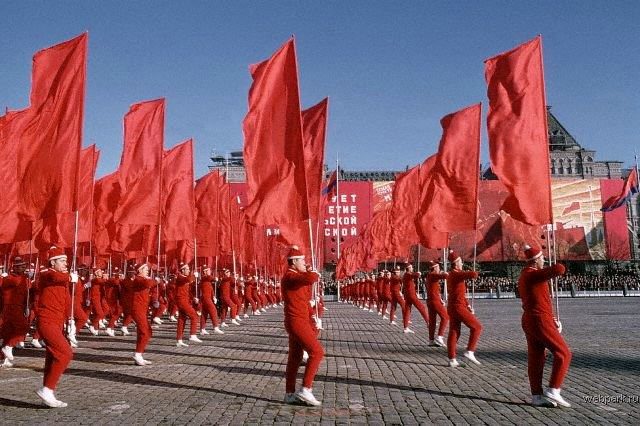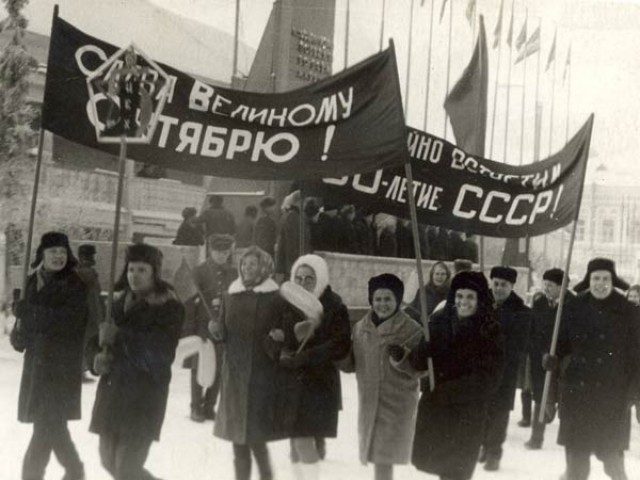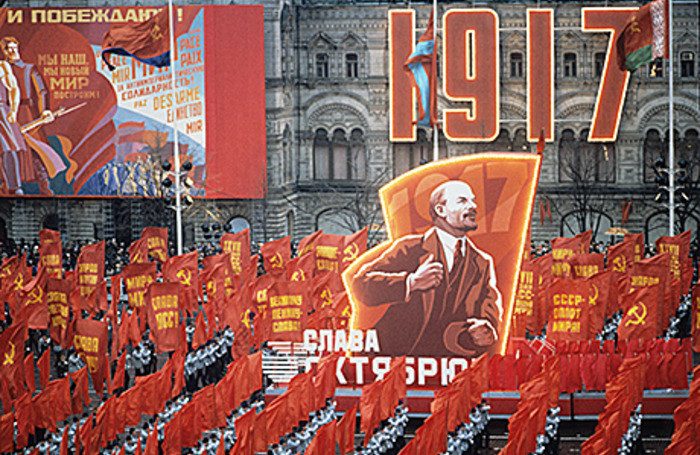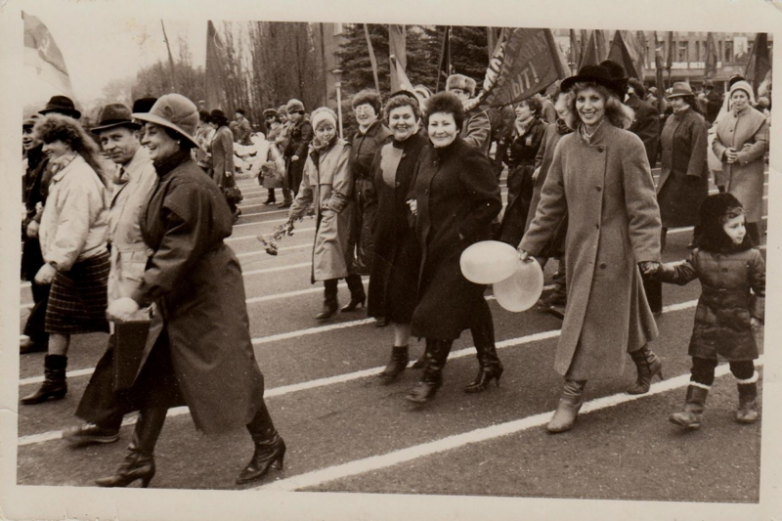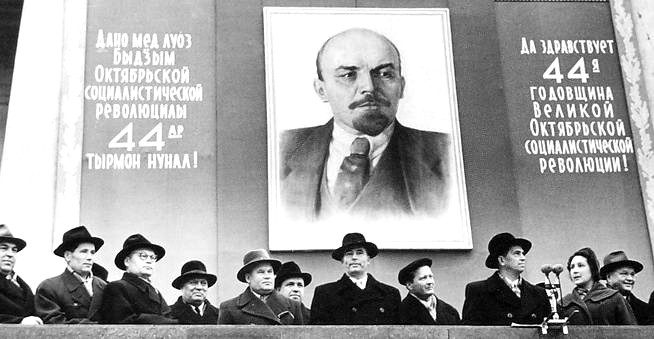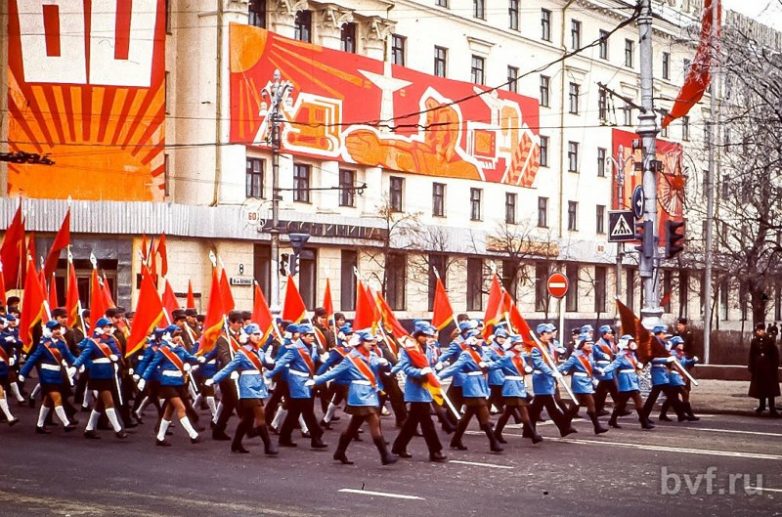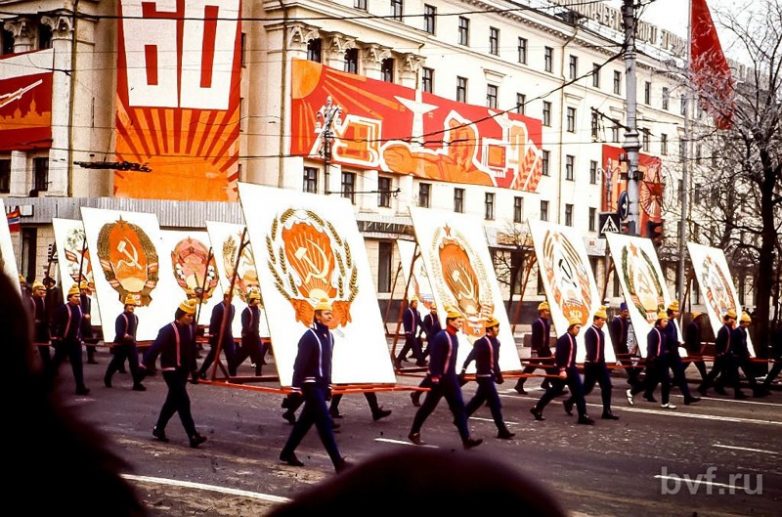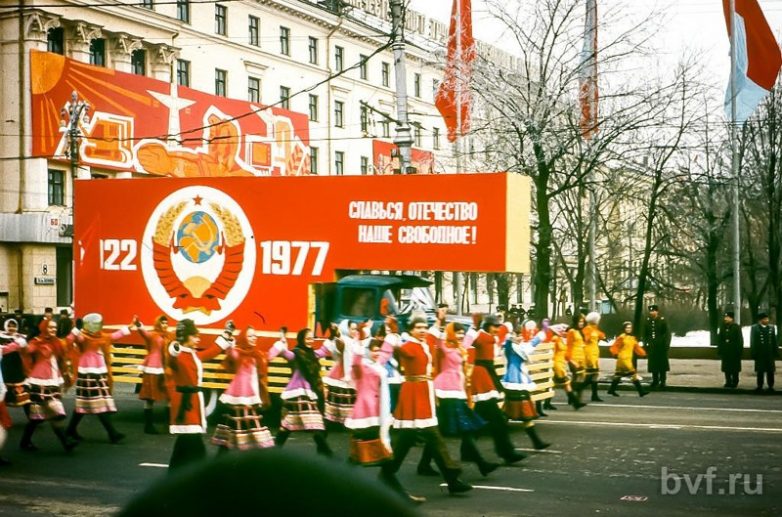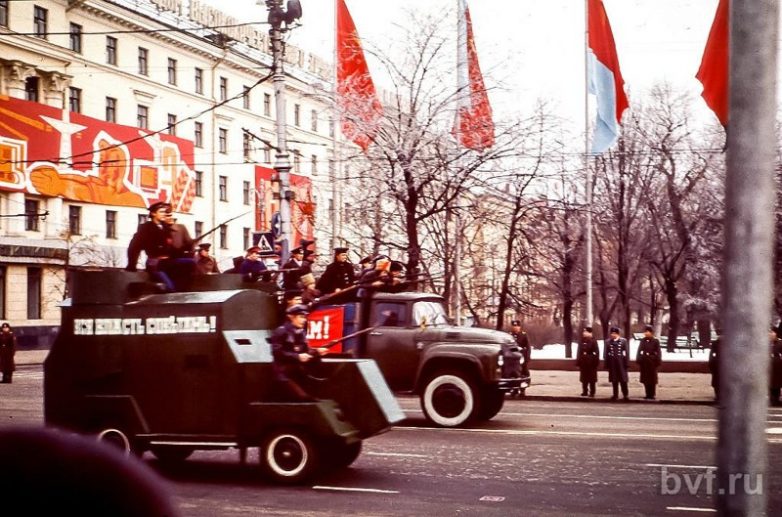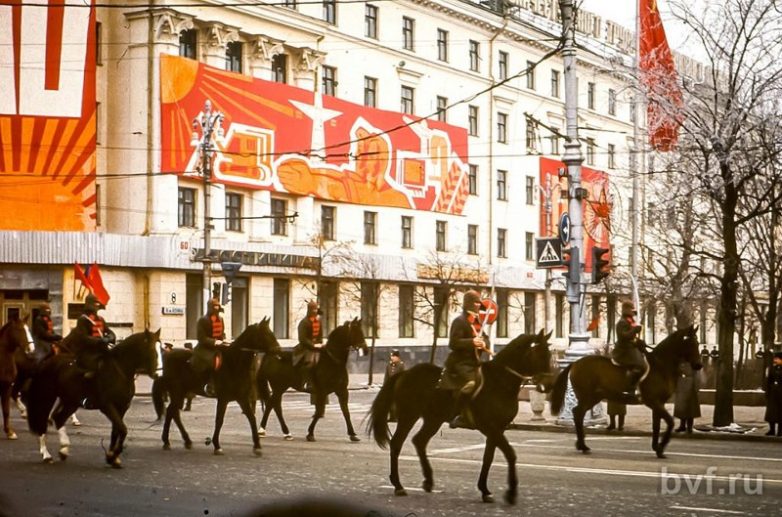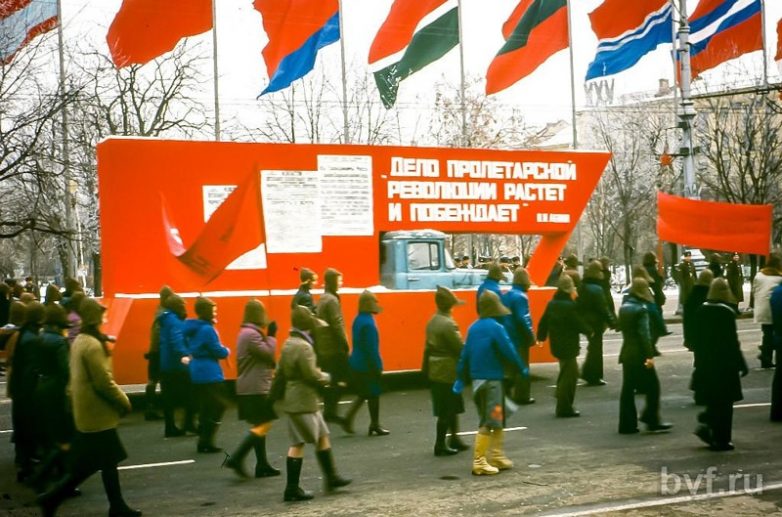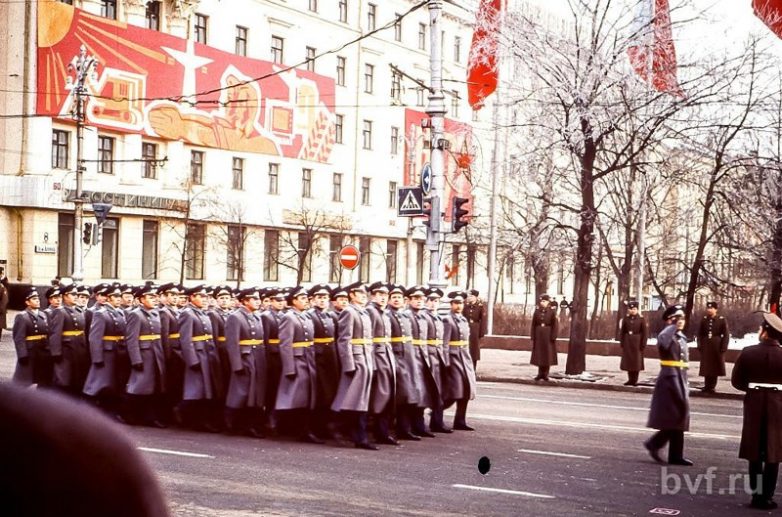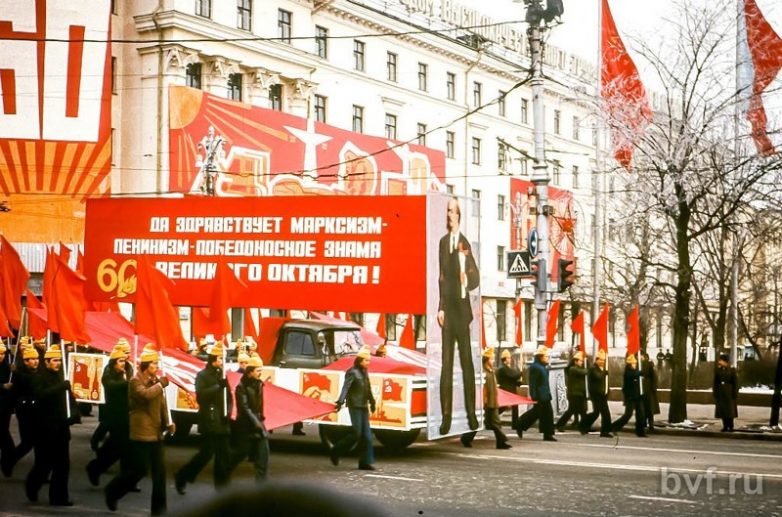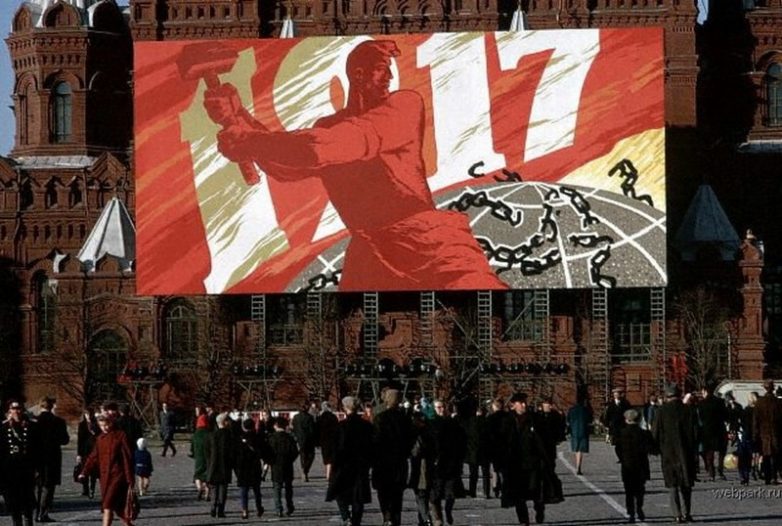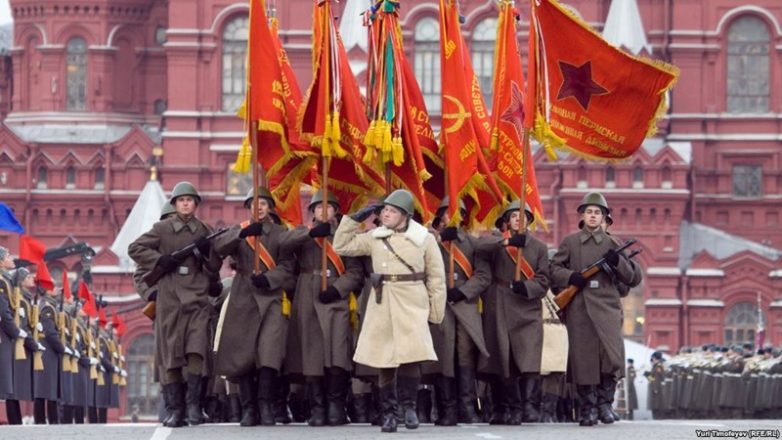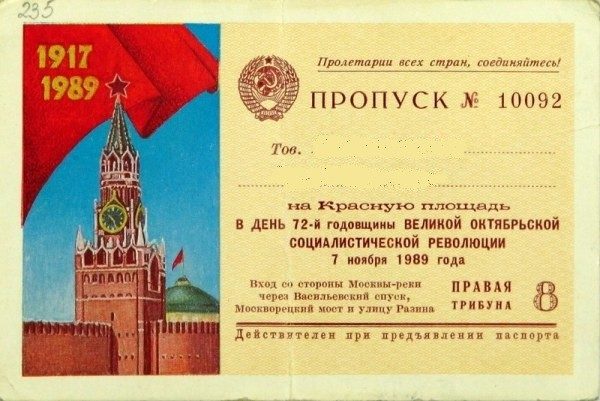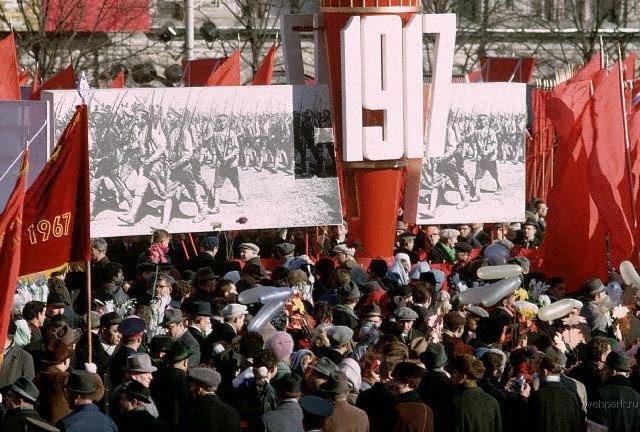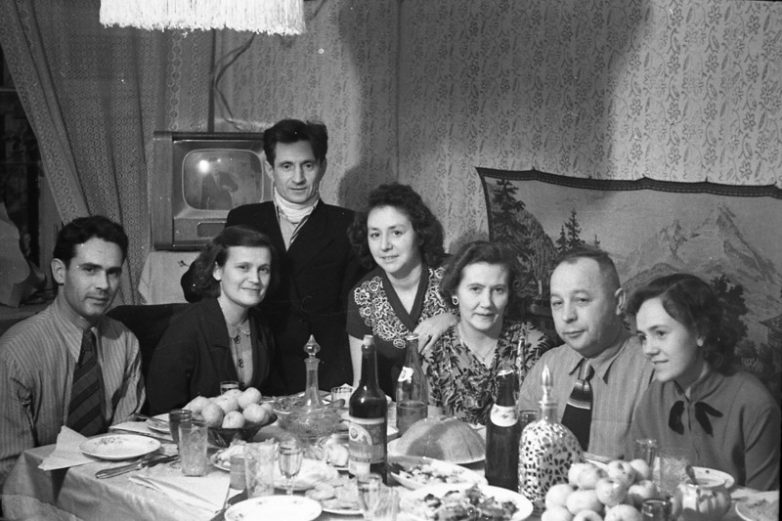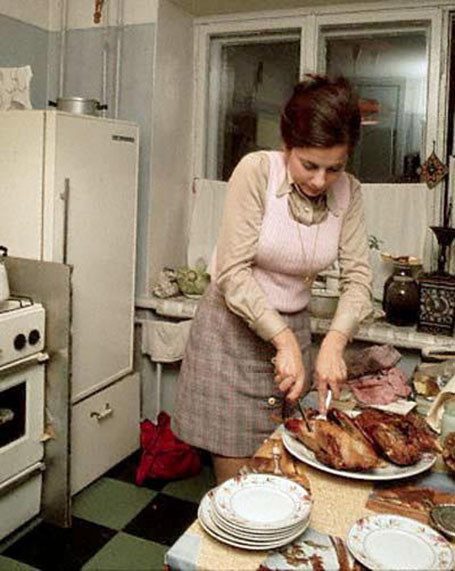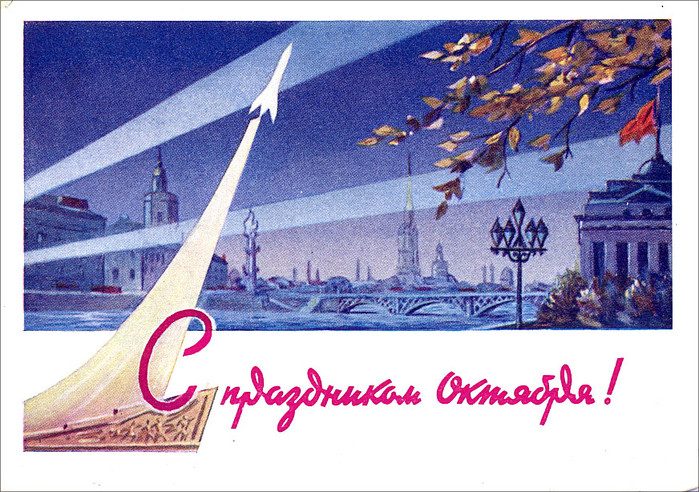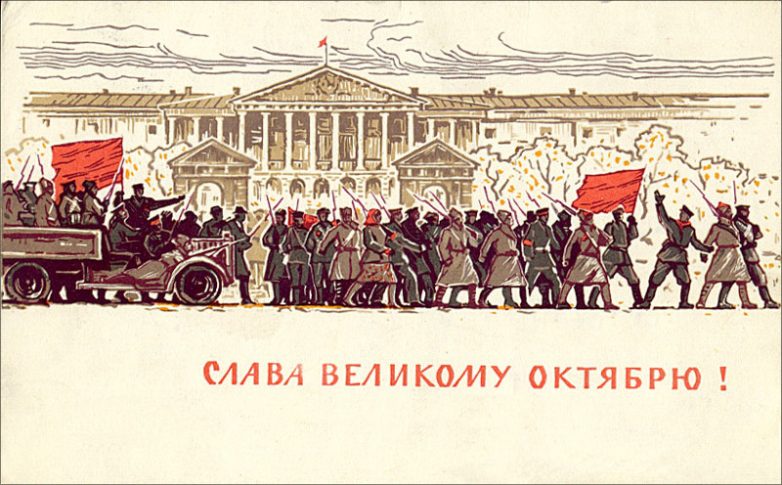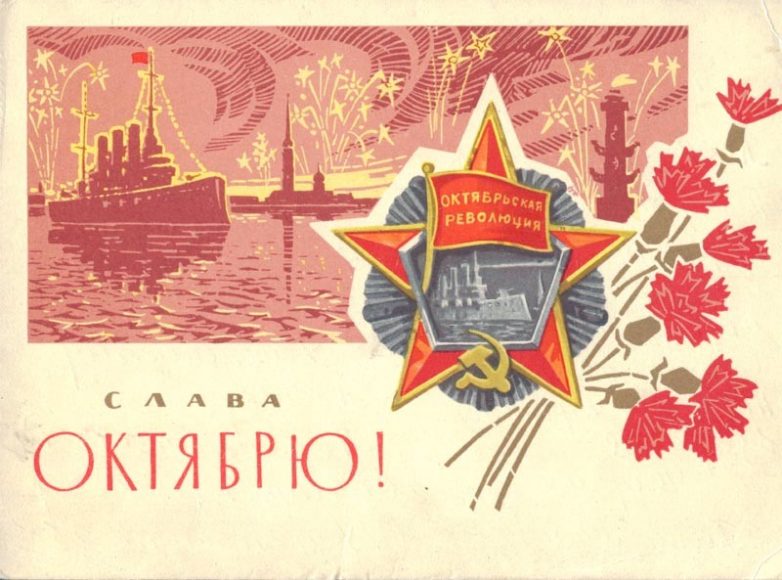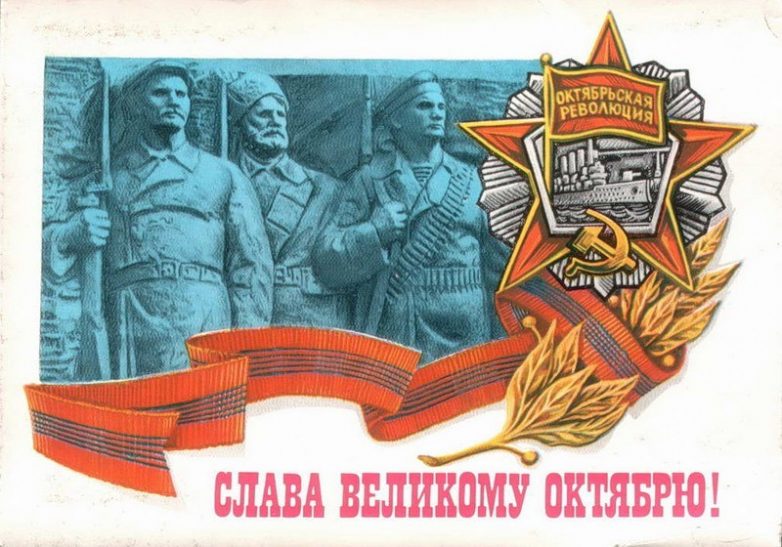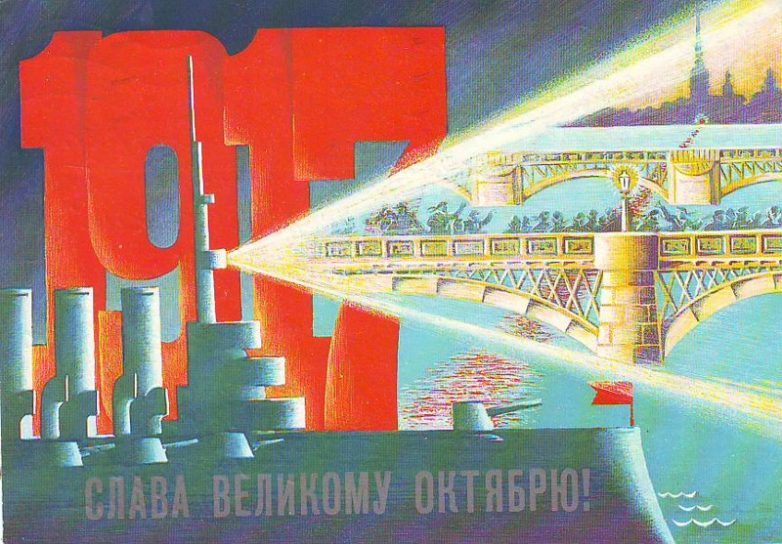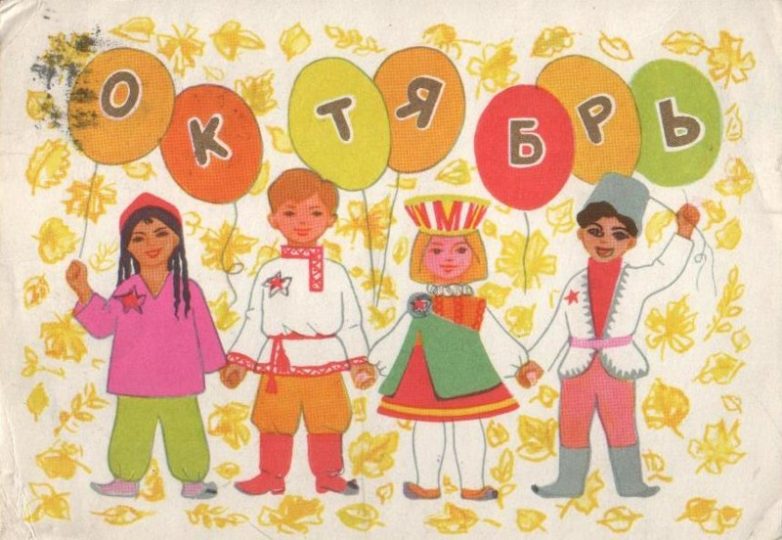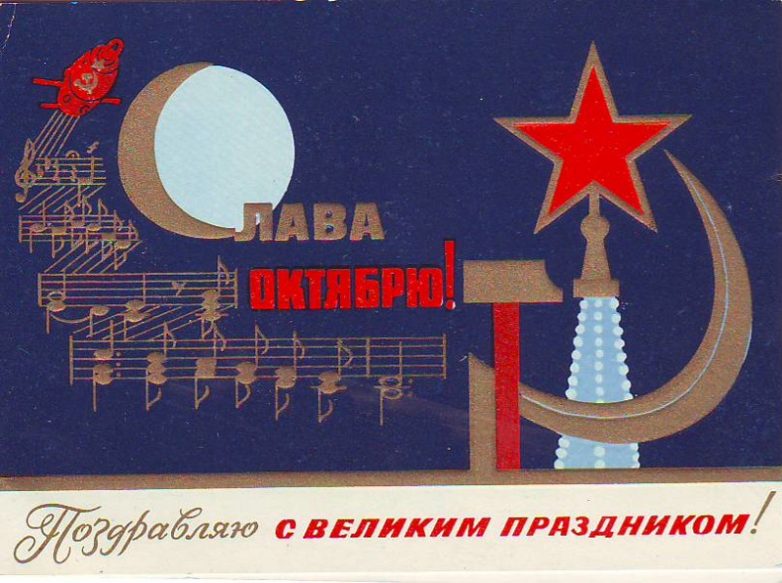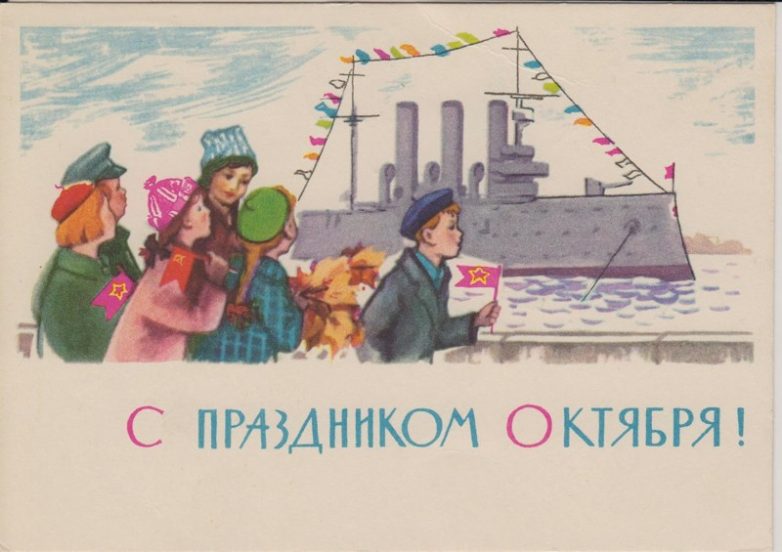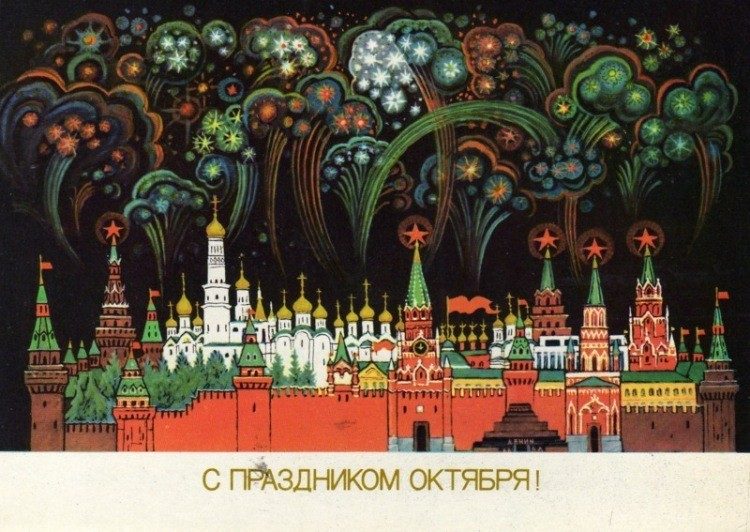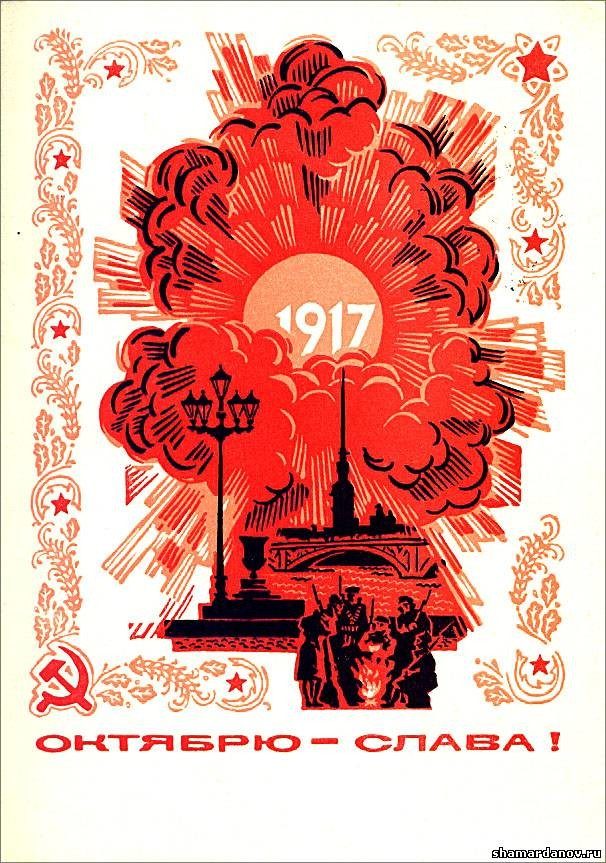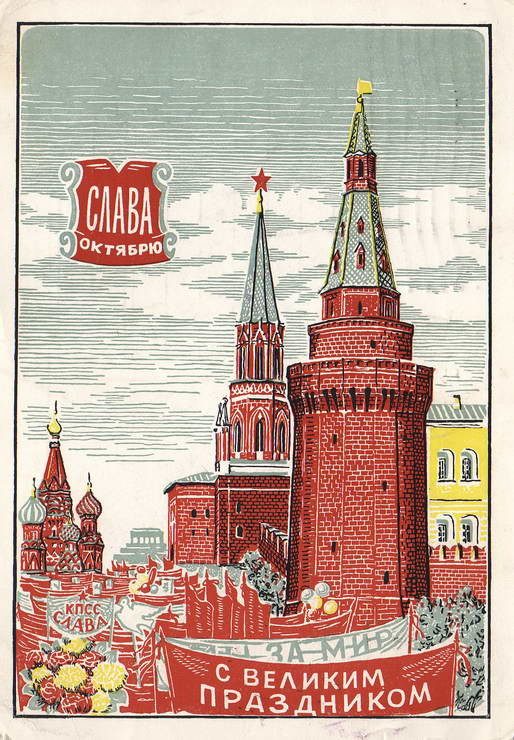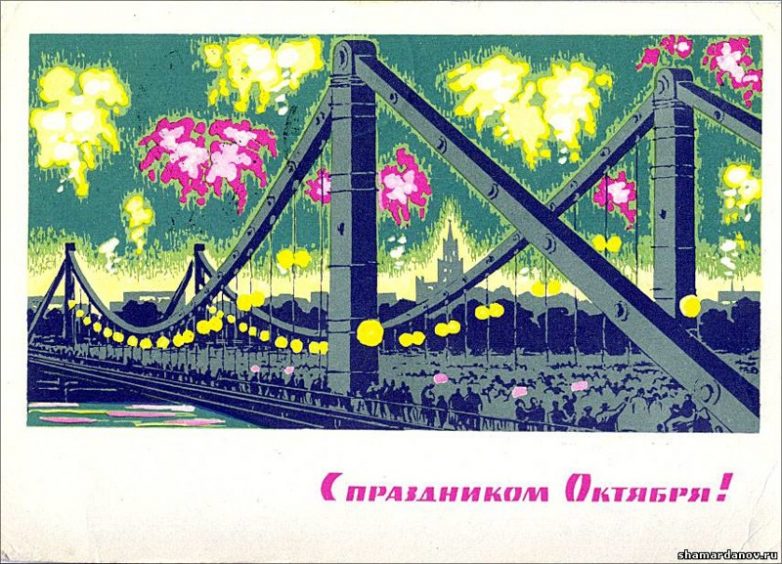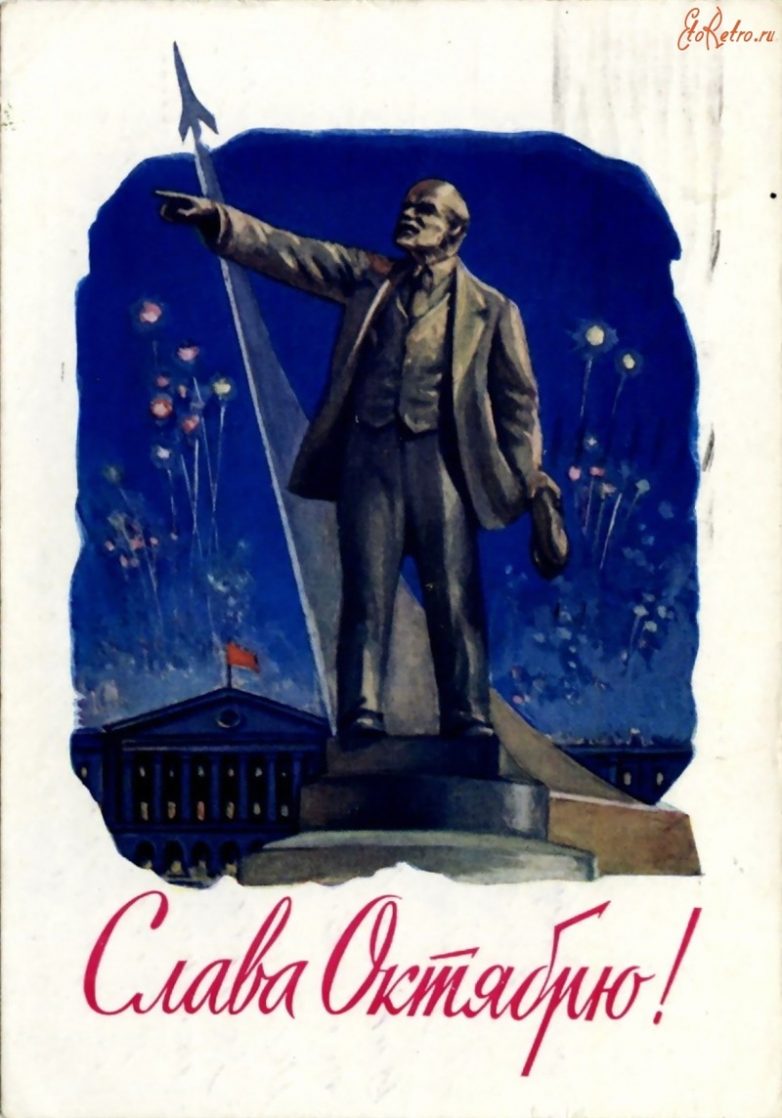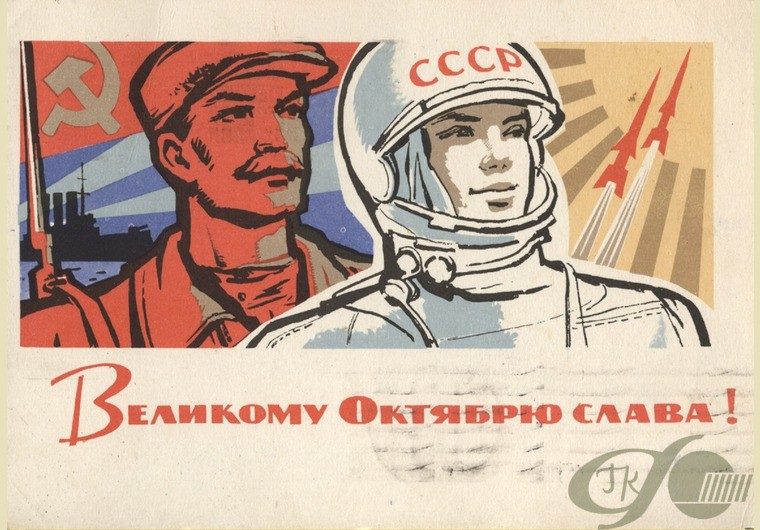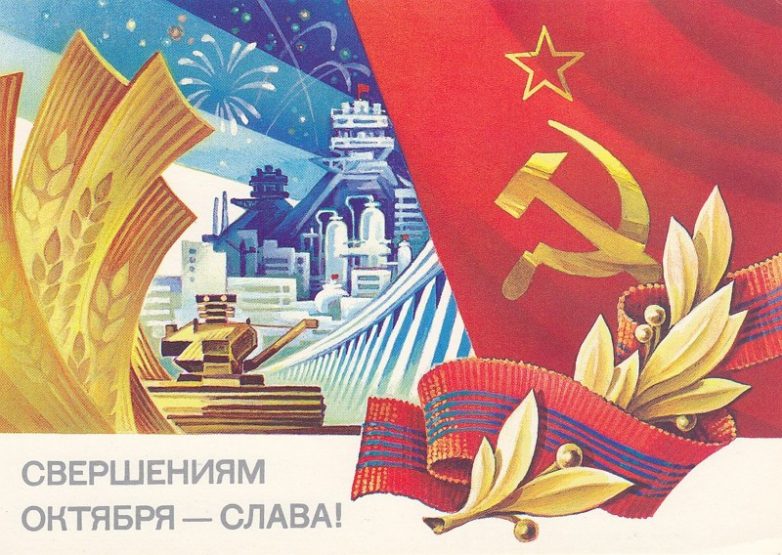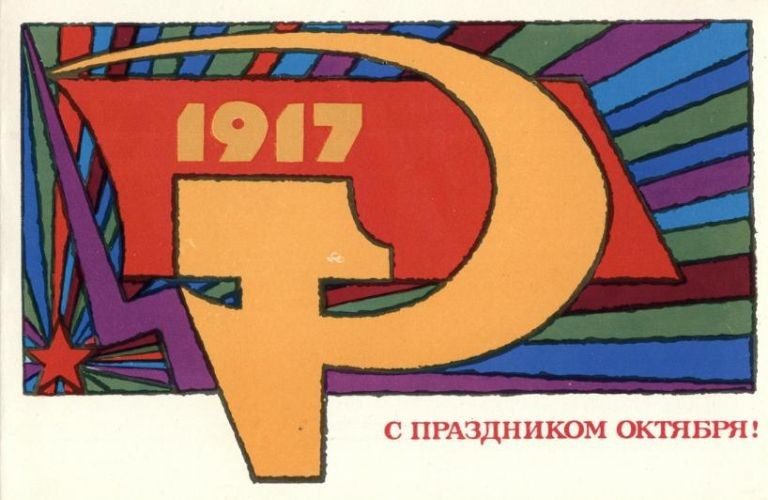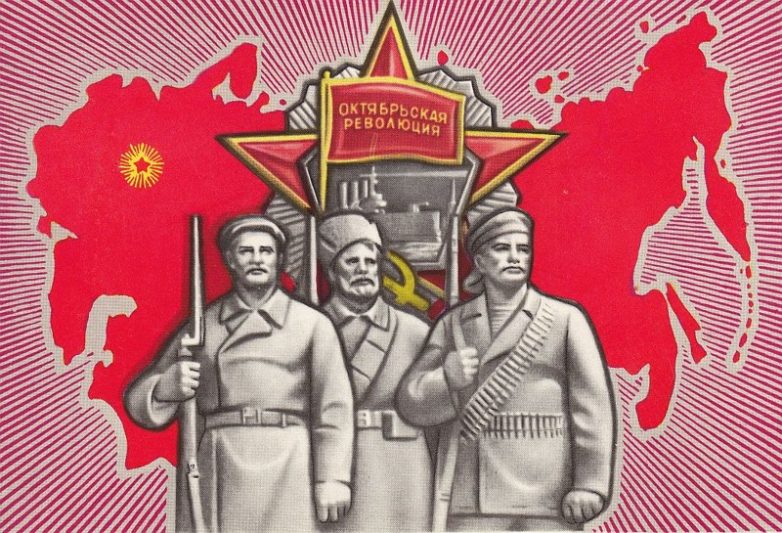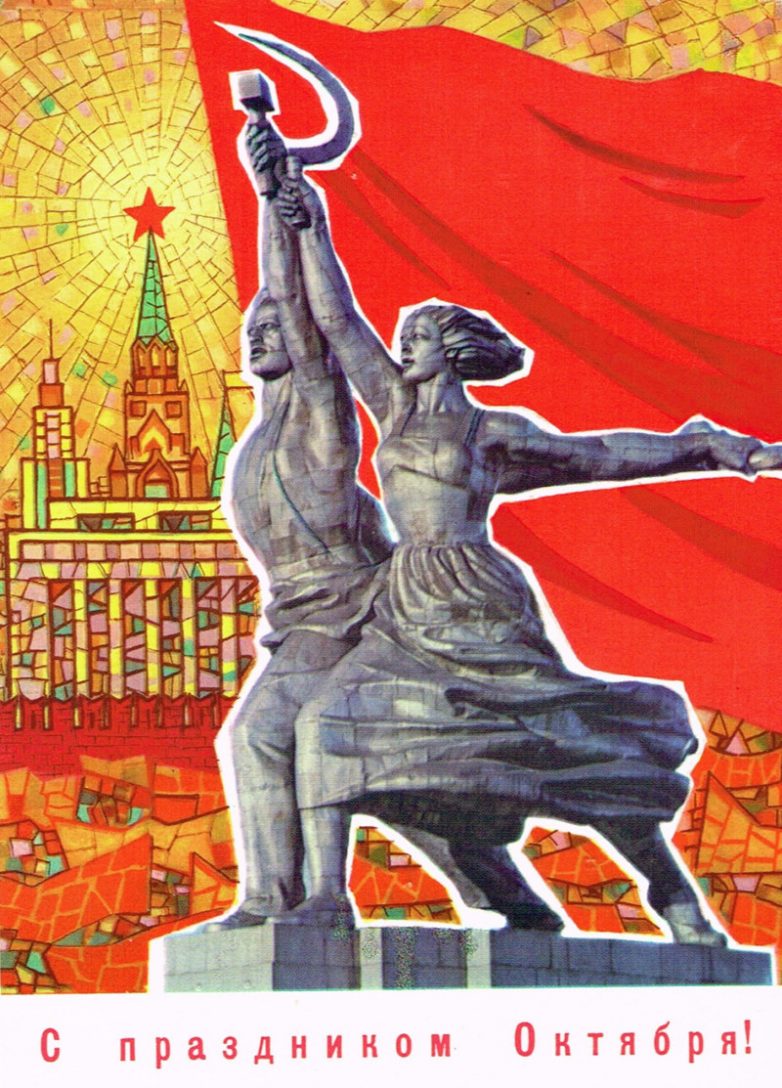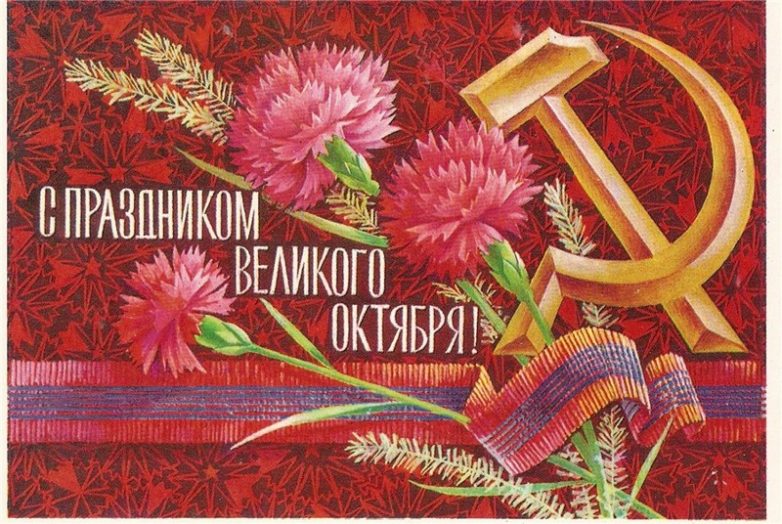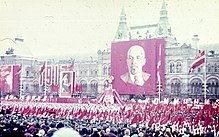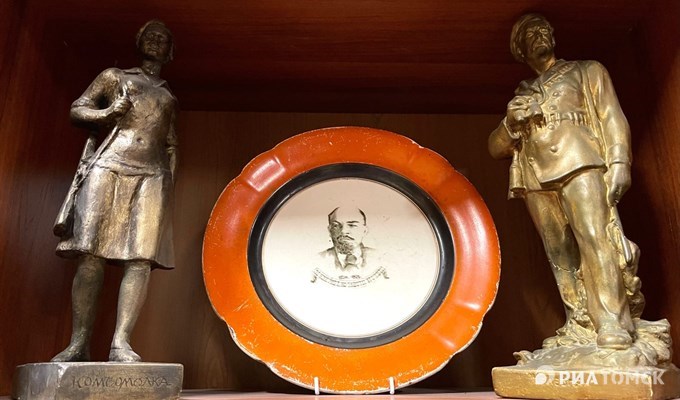7 ноября советские люди отмечали, бесспорно, главный праздник Советского Союза — День Великой Октябрьской социалистической революции. Идеологическая основа была проста – праздновали день рождения нового государства рабочих и крестьян. И конечно, каждый школьник знал, почему День Октябрьской революции отмечается в начале ноября.
Ежегодно 7 ноября парады шли по главным площадям городов страны. За ними следовали и демонстрации трудящихся. На трибуны выходили первые лица региона, принимавшие парад и приветствовавшие трудящихся, а также студентов и школьников, которые маршировали с флагами, плакатами и транспарантами в руках…
1940 год
1955 год, Воронеж
1958 год
1987 год
День седьмого ноября –
Красный день календаря.
Посмотри в свое окно:
Все на улице красно!
1972 год, г. Кунгур
Главные торжества проходили, конечно же, на Красной площади. Но свои парады и демонстрации были в каждом областном или краевом центре СССР.
Демонстрация 7 ноября 1977 года в Воронеже (серия фото из архива Эрхарда Ройтера, студента ВГУ в 1974-79 гг,)
1967 год, 50 лет советской власти
1989 год
Гражданам Страны Советов полагалось по этому поводу два выходных дня: 7 и 8 ноября: так постановил Президиум ЦИК СССР в 1927 году, в честь первой десятилетней годовщины революции.
После официальной части переходили к праздничному застолью. Каждая хозяйка приберегала что-то из дефицитного (в зависимости от года) к такому моменту: баночку икры или венгерского горошка, крабов или просто майонеза. Собирались гости, звучали тосты, а затем песни и танцы, насколько позволяла площадь квартир и комнат.
Друзьям и родственникам было принято отправлять к 7 ноября поздравительные открытки. Среди выпускавшихся огромными тиражами почтовых картонок встречались и настоящие шедевры!
Просто удивительно, насколько разные сюжеты для этих открыток удавалось найти и изобразить художникам! И надписи тоже радуют разнообразием…
Последний военный парад на Красной площади Москвы в ознаменование годовщины Октябрьской революции состоялся в 1990 году. С 1992 года в России 8 ноября стало рабочим днем. С 1996 года вместо Годовщины Великой Октябрьской социалистической революции решено отмечать День согласия и примирения. А в 2005 году в российском календаре появляется новый праздник — День народного единства, который отмечается 4 ноября, и 7-е тоже перестает быть выходным днем.
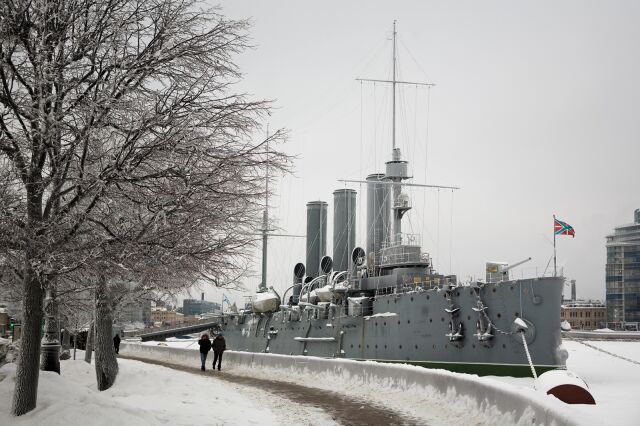
Ежегодно 7 ноября в России отмечается памятная дата — День Октябрьской революции 1917 года.
Формально этот праздник был учрежден в 2005 году, но на самом деле имеет давнюю историю и знаком любому человеку, родившемуся и воспитанному в Советском Союзе. С 1918 и по 1991 год день 7 ноября был главным советским праздником и носил название — День Великой Октябрьской социалистической революции.
В течение всей советской эпохи 7 ноября был «красным днем календаря», то есть государственным праздником СССР, который отмечали не только особым цветом в ежедневнике, но и обязательными демонстрациями трудящихся, проходившими в каждом городе страны. История этого праздника закончилась с распадом Советского Союза и развенчанием коммунистической идеологии.
В современной России праздник был переименован сначала в День согласия и примирения (с намеком на необходимое примирение сторонников разных идеологических взглядов), а затем и упразднен вовсе. Впрочем, в некоторых бывших республиках СССР он продолжает существовать и по сей день: в Кыргызстане 7 ноября остается выходным днем и государственным праздником (но поменял название), в Беларуси он отмечается как День Октябрьской революции.
В России 7 ноября перестало быть праздником, но вошло в перечень памятных дат. Соответствующий закон был принят в 2005 году. Ведь несмотря на спорную идеологическую подоплеку бывшего праздника, сложно отрицать значение этой даты в истории страны. Восстание в Петрограде в 1917 году, завершившееся социалистической революцией, предопределило все дальнейшее развитие не только России, но и ряда других государств мира.
Для тех, кто изучал историю уже в современной России и, возможно, уделил недостаточно вниманию этой вехе, стоит напомнить. В ночь с 7 на 8 ноября (по новому стилю, а по старом стилю это произошло с 25 на 26 октября) 1917 года в Петрограде произошло восстание. По сигналу, которым стал выстрел крейсера «Аврора», вооруженные рабочие, солдаты и матросы захватили Зимний дворец, свергли Временное правительство и провозгласили Власть Советов, которая просуществовала в стране 73 года.
В результате Октябрьской революции 1917 года изменился государственно-политический, идеологический и общественно-экономический строй страны, на большей части территории бывшей Российской империи образовалось государство, получившее в 1922 году название Союз Советских Социалистических Республик.
Кстати, легендарный крейсер — символ Октябрьской революции — в ноябре 1948 года был выведен из состава флота и поставлен на вечную стоянку у Петроградской набережной в Ленинграде (сегодня — Санкт-Петербург). Он является кораблем-музеем, филиалом Центрального военно-морского музея, а также — объектом культурного наследия Российской Федерации.
Материалы по теме в Журнале Calend.ru:
Инфографика – постер «7 ноября — День Октябрьской революции 1917 года в России»
Рассказ «Ответственная за транспаранты»
From Wikipedia, the free encyclopedia
| День Великой Октябрьской социалистической революции Day of the Great October Socialist Revolution |
|
|---|---|

October Revolution Day in 1977 |
|
| Observed by |
|
| Type | National Day |
| Celebrations | Flag hoisting, parades, fireworks, award ceremonies, singing patriotic songs and the national anthem, speeches by the CPSU General Secretary, entertainment and cultural programs |
| Date | 7 November |
| Next time | 7 November 2023 |
| Frequency | annual |
| Related to | Great October Socialist Revolution |
Anniversary of October Revolution in Riga, Latvia, Soviet Union in 1988.
October Revolution Day (officially Day of the Great October Socialist Revolution, Russian: День Великой Октябрьской социалистической революции) was a public holiday in the Soviet Union and other Soviet-aligned states, officially observed on November 7 from 1927 to 1990,[1] commemorating the 1917 October Revolution.
For Soviet families, it was a holiday tradition to partake in a shared morning meal, and to watch the October Revolution Parade broadcast on Soviet Central Television.[1]
A holiday canon was established during the Stalinist period, and included a workers’ demonstration, the appearance of leaders on the podium of the Mausoleum, and, finally, the military parade on Red Square, which was held unfailingly every year, and most famously in 1941, as the Axis forces were advancing on Moscow.[2]
October Revolution Day, which had been the main holiday of the year and received most of its traditions during the Stalinist period, gradually became less popular in the 1970s, falling behind the Victory Day and New Year celebrations as personal and family holidays.[2]
Soviet observances[edit]
Civil-military parade[edit]
History[edit]
The 20th anniversary parade in 1937.
The first military parade took place on 7 November 1919 on the second anniversary of the revolution. The Russian civil war lasted until 1923. The parade in 1941 is particularly revered as it took place during the Battle of Moscow, during which many of the soldiers on the parade would be killed in action. In 1953, the parade took place as the first one to not be inspected by officers on horseback.[3] The practice of foreign leaders began in 1957 with Mao Zedong attending that year’s parade as part of a state visit, continuing throughout the next two decades with Ethiopian leader Mengistu Haile Mariam’s attendance in 1980 and the leaders of Warsaw Pact and USSR-allied nations in 1967, 1977 and 1987. The 1989 parade was the first to have a drill routine by the massed bands take place. During the final parade in 1990, an assassination attempt was made on the life of President Mikhail Gorbachev by Alexander Shmonov, a locksmith from Leningrad. The two bullets he fired missed as he was tackled to the ground by crowds of demonstrators.[4] The only time that a Soviet leader never attended a parade was in 1983 when Yuri Andropov did not attend the parade due to a sickness and his associate Konstantin Chernenko stood in for him.[5]
Description of the parade[edit]
The most important event of the holiday is the national military parade and demonstrations on Moscow’s Red Square, with members of the Politburo and the Central Committee of the Communist Party of the Soviet Union acting as the guests of honor. The celebrations begin at 9:50 am Moscow Standard Time with the arrival honors for the commander of the parade, who is greeted by the commandant of the Frunze Military Academy (now the Combined Arms Academy of the Armed Forces of the Russian Federation) usually a general officer, and receives the report on the parade’s status. Once the parade commander (who is usually a Colonel General with the billet of Commander of the Moscow Military District) receives the report, he takes his position in the parade and orders the formations to stand at ease. A couple minutes later, a Communist Party and government delegation arrives at the grandstand on top of Lenin’s Mausoleum. The dignitaries include the General Secretary, Premier, the Chairman of the Presidium of the Supreme Soviet, members of the entire Central Committee of the Communist Party of the Soviet Union, including members from the Politburo and Secretariat, the Chief of the General Staff of the Armed Forces, service branch commanders, deputy defence ministers, members of the cabinet and commanders of the support departments in the general staff, in addition to the occasional foreign head of state or party as the principal foreign guest and reviewing officer. In between the south of the grandstand is a platoon of the armed linemen and markers from the Independent Commandant’s Regiment in military overcoats whose purpose is to take post to mark the distance of the troops marching past. Seated in the stands on the west and east sides were residents of the capital, visitors from all over the Union, the diplomatic corps and military attaches and guests from allied and friendly countries with ties to the Union government. Within Red Square the more than 9,000 strong parade formation (11,000 during jubilee years) was complemented by the Massed Bands of the Moscow Garrison, conducted by the Senior Director of Music of the Military Band Service of the Armed Forces, the billet of an officer who usually held major general rank, at the start of the parade the bands were split into four sections across the expanse of the Square in between the inspecting formations. The mobile column, also present, was made up of around 170-380 vehicles and around 3,900 crews drawn from the participant units making up the segment of the parade. Until 1974 the mobile column was around 400 to 750 vehicles strong made up of around 7,500 to 9,800 crews and officers from the formations making up the column.
Badges[edit]
In November 1967 Minister of Defense Marshal Andrei Grechko announced his gratitude and of the Ministry of Defence to all those who marched on Red Square that 7 November as the country marked the golden jubilee anniversary year of the Revolution and for the first time, together with the text of gratitude, they were presented with commemorative badges «Participant of the military parade». Participants were also awarded a commemorative badge in the 1972 parade, the 100th parade to mark the golden jubilee of the foundation of the Soviet Union. A number of naval schools had custom made badges made in honor of their participation in the celebrations.[6]
Parade proper[edit]
The Leningrad parade in 1983.
As the Kremlin’s Spasskaya Tower sounds the chimes at 10am the parade commander orders the parade to present arms and look to the left for inspection. The Minister of Defence (usually a billet of a General of the Army) then is driven on a limousine to the center of the square to receive the parade report from the commander, with the combined bands playing Jubillee March of the Red Army in the background. Once the report is received, the Minister and the parade commander begin to inspect the parading formations together with the bands. The limousinesed stop at each formation in order for the minister to send his greeting to the contingents, in which they respond with a threefold «Ura» (Russian: Ура). Other than the Red Square inspection, the commander and the minister would also inspect the personnel of the mobile column on Manezhnaya Square. After the final greeting, the Massed Bands played Long Live our State by Boris Alexandrovich Alexandrov as the commander returns to his place in the parade, and the Minister driven to the grandstand while the entire parade shouts ‘Ura!’ (Russian: Ура!) repeatedly until he takes his position in the grandstand and the bands end playing (from 1945 to 1966 Slavsya from A Life for the Tsar took its place and yet again in 1990). During this time, the Corps of Drums of the Moscow Military Music College, which is an affiliate of the Suvorov Military Schools, take their place behind the parade commander’s limousine. The parade is then ordered to stand at ease and the chromatic fanfare trumpeters, together with the rest of the musicians of the massed bands, sound a fanfare call, usually Govovin’s Moscow Fanfare for the keynote address by the minister which will follow. As the minister concludes his address, he will yell «Ura!» (Russian: «Ура!») to which the entire parade repeats thrice. The Massed Bands of the Moscow Garrison then play the full version of the State Anthem of the Soviet Union while a ceremonial battery armed with the 76 mm divisional gun M1942 (ZiS-3) fire a 21-gun salute. As the anthem ends, the bands sound a second fanfare and the parade commander orders the parade to do carry out the following commands for the march past:
-
- Parade… attention! Ceremonial march past!
Form battalions! Distance by a single lineman! First battalion will remain in the right, remainder… left.. turn!
Slope.. arms!
Eyes to the right…
Quick march!
- Parade… attention! Ceremonial march past!
On the command «Quick march!», the linemen take their places at the south end of the square while the Corps of Drums of the Moscow Military Music College march to a drum tune, while the fifers and trumpeters play a specific tune, in a tradition that would go on until the late 1990s and early 2000s when the trumpets were removed. As the massed bands start playing the Corps of Drums begin to swing their drumsticks while on the eyes right led by the drum major. The Corps is immediately followed by the officers of the Frunze Military Academy whereas on jubilee parades, the massed colour guard is the first formation other than the corps on the square, followed by a historical contingent. The troops have always marched in the following order during the parade:
Order of ground march past column[edit]
Military Bands
- Massed Bands of the Moscow Military District under the direction of the Senior Director of Music of the Bands Service
- Corps of Drums of the Moscow Military Music College
Ground Column
- Parade commander holding the appointment of commanding officer of the Moscow Military District
- Color Guard Unit (in jubilee parades)
- Historical contingent (in jubilee parades)
- Red Guards
- Ex-Imperial Russian Army servicemen within the Red Army
- Sailors of the Aurora
- Red Army soldiers during the Civil War
- Great Patriotic War contingent
- Frunze Military Academy
- V.I. Lenin Military Political Academy
- Felix Dzerzhinsky Artillery Academy
- Military Armored Forces Academy Marshal Rodion Malinovsky
- Military Engineering Academy
- Military Academy of Chemical Defense and Control
- Yuri Gagarin Air Force Academy
- Prof. Nikolai Zhukovsky Air Force Engineering Academy
- Delegation of naval officer cadets from the Soviet Navy[7]
- 98th Guards Airborne Division
- Moscow Border Guards Institute of the Border Defence Forces of the KGB «Moscow City Council»
- Separate Operational Purpose Division
- 336th Marine Brigade of the Baltic Fleet
- Suvorov Military School
- Nakhimov Naval School
- Moscow Military Combined Arms Command Training School «Supreme Soviet of the Russian SFSR»
As ground column concludes, the massed bands play either Long Live our State or Song of the Motherland, with the Moscow Higher Military Command School marching past as the last formation on the square before the mobile column with Victory Day being played beforehand as their cadets march at the rear. When the ground segment ends, the bands perform an about turn and march towards the facade of the GUM department store to give way to the mobile column, which drives past as the bands play Victorious March and Moscow Salute. Once the ground mobile column is complete, the bands take their position at the western end of the square to prepare for the finale, led by the senior director of music, conductors, bandmasters and drum majors. The finale involves the massed bands marching down the square to the tune of Song of the Soviet Army or Metropolitan March and as the bands march past the grandstand, the senior director of music, conductors and bandmasters salute at the eyes right. In 1967, the massed bands marched out to the tune of My Beloved Motherland.
Order of mobile column drivepast[edit]
- 2nd Guards Motor Rifle Division
- 98th Guards Airborne Division
- 4th Guards Tank Division
- Moscow Military District Field Artillery and Rocket Forces
- Moscow Military District Ground Forces Air Defense
- 1st Moscow Air and Air Defense Forces Army
- Northern Fleet and Baltic Fleet Coastal Defense, Surface and Submarine Forces (until 1974)
- Strategic Missile Forces 27th Guards Rocket Army
Similar parade events were held in all major cities in the RSFSR as well as in the USSR, with the first secretary of the local communist party branch being the guest of honor and the commander of the regional military district or large formation acting as the parade inspector and keynote speaker, while the second-in command of the unit or command served as parade commander. The parade format is the same in these cities, with particularities being shaped to fit the specific parade ground (e.g. October Square, Minsk). Massed bands for the parade were drawn from the formation or district bands located in their respective areas. The Government of the Armenian SSR cancelled the 1989 parade in Yerevan due to extended protests, while the mobile column of the parade in the Moldovan capital of Kishinev was removed from the itinerary due to protester blocking the streets and preventing passage to vehicles.[8] A similar occurred event occurred on what is now Gediminas Avenue in Vilnius.[9]
Civil parade and workers’ demonstration[edit]
Workers demonstration in Moscow in 1977
The bands having marched off the square is the signal for the commencement of the holiday civil parade and workers’ demonstration in Red Square. In jubilee years (more frequency in the parades of the 1960s and 1970s), the civil parade kicks off with a spectacular march made up of the following components preceding the workers’ demonstration march:
- Red flag bearers
- Historical segment (present in the parades of 1967 and 1987)
- Officials, management, staff and employees of the Moscow City CPSU Committee and Moscow City Council
- Representatives of state economic enterprises and firms in Moscow
- Komsomol
- Vladimir Lenin All-Union Pioneer Organization
- DOSAAF
- Color Guard, Athletes and Coaches from the Voluntary Sports Societies of the Soviet Union
- Moscow National Central Physical Fitness and Sports School
The logo of the 1987 celebrations.
Float displays also featured prominently in the civil parades where floats were designed to promote government and party campaigns or highlight the works of various public companies, farm collectives and state economic firms. At a certain point during the civil parade, Pioneers in winter jackets and carrying flowers representing schools in Moscow and all over the country run towards the front of the Mausoleum facade and are split into two groups that ascend the staircases towards the dignitaries in the grandstand to give them flower bouquets. Following the civil parade the workers’ demonstration officially begins, wherein workers from state economic and social firms in Moscow, as well as from schools and universities, march past as part of their respective community delegations. Each delegation has a color guard unit and brass band taking part, as well as floats from the participating state enterprises. Each of Moscow’s districts march past the grandstand to greet everyone a Happy Revolution Day, especially to the dignitaries and everyone in the stands watching as balloons fly out from the crowds filing past while recorded music is played on the speakers. After an hour or two, the civil parade ends with a huge crowd bidding the principal dignitaries farewell from the grounds of the square with red flags in their hands as one final cheer resounds from the sound systems installed along the entire length of the square.
Similar civil parades occurred in all major cities and the republican capital cities following the military parades.
Post-Soviet observance[edit]
CPRF celebrations in 2009.
In Russia, the holiday was repurposed several times. In 1995, President Yeltsin reestablished a November 7 holiday to commemorate the liberation of Moscow from the Polish-Lithuanian Army in 1612.[2] The next year, it was renamed ‘Day of Accord and Reconciliation’.[2] From 2004, November 7 became one of several Days of Military Honour and ceased to be a day off.[1] The original celebrations continues to be honoured in ceremonies led by the Communist Party of the Russian Federation.
As of 2018, October Revolution Day remains an official holiday in Belarus, though the original significance has faded and it is simply regarded as a day off.[10] President Alexander Lukashenko has described the holiday as one that «strengthens social harmony».[11] Similarly, in the unrecognized Pridnestrovian Transnistrian Republic, the day is officially a public holiday, but it is regarded by locals as devoid of its original meaning.[12][citation needed] In Kyrgyzstan, the holiday was observed until 2017, when it was replaced by the ‘Days of Ancestral History and Memory’ on November 7 and 8.[13]
Observance in the United States[edit]
A handful of U.S. states[which?] designate November 7 as Victims of Communism Day. In 2022, the state of Florida in the United States, mandated that schools devote 45 minutes to teaching about communism, the role that communist leaders have had on history and «how people suffered under those regimes».[14]
See also[edit]
- Declaration of the Creation of the Union of Soviet Socialist Republics
- List of October Revolution Parades in Moscow
- Victory Day (9 May)
- Golden Week (China)
- National Day of the People’s Republic of China
References[edit]
- ^ a b c «День Октябрьской революции 1917 года». РИА Новости (in Russian). 7 November 2017. Archived from the original on 2017-11-11. Retrieved 26 October 2018.
- ^ a b c d «7 ноября: пять праздников одного дня. Справка». РИА Новости (in Russian). 7 November 2008. Archived from the original on 2015-05-18. Retrieved 27 October 2018.
- ^ «Parades — November 7th». www.globalsecurity.org. Retrieved Jan 31, 2023.
- ^ Levkovich, Yevgeny (2017-02-16). «The last Soviet terrorist: The man who tried to assassinate Gorbachev». Russia Beyond The Headlines. Retrieved 2017-03-30.
- ^ Times, Serge Schmemann, Special To The New York (1983-11-08). «ANDROPOV MISSES MOSCOW PARADE, STIRRING RUMORS». The New York Times. ISSN 0362-4331. Retrieved 2019-10-13.
- ^ «Нагрудные знаки участникам московских парадов». izhig.ru. Retrieved 2020-07-28.
- ^ «По Брусчатке Красной Площади».
- ^ «Soviet Revolution Day celebrations disrupted». UPI. Retrieved 2017-02-11.
- ^ LordBenas (2008-05-24), 1989 sovietinis paradas Gedimino prospektu., retrieved 2017-03-20
- ^ «Минчане о 7 ноября: «Это праздник, но какой — не помню»«. Комсомольской правды (in Russian). 6 November 2016. Retrieved 26 October 2018.
- ^ https://m.eng.belta.by/president/view/lukashenko-memory-of-october-revolution-strengthens-social-harmony-125652-2019/
- ^ «7 ноября в Приднестровье по-пролетарски празднуют лишь коммунисты». Deutsche Welle (in Russian). 7 November 2009. Archived from the original on 2017-05-22. Retrieved 26 October 2018.
- ^ «Президент Киргизии постановил отмечать 7-8 ноября Дни истории и памяти предков». Interfax.ru (in Russian). 26 October 2017. Archived from the original on 2018-06-01. Retrieved 26 October 2018.
- ^ «DeSantis signs bill mandating communism lessons in class, as GOP leans on education». MSN. Retrieved 2022-05-10.
External link[edit]
Media related to October Revolution Day at Wikimedia Commons
From Wikipedia, the free encyclopedia
| День Великой Октябрьской социалистической революции Day of the Great October Socialist Revolution |
|
|---|---|

October Revolution Day in 1977 |
|
| Observed by |
|
| Type | National Day |
| Celebrations | Flag hoisting, parades, fireworks, award ceremonies, singing patriotic songs and the national anthem, speeches by the CPSU General Secretary, entertainment and cultural programs |
| Date | 7 November |
| Next time | 7 November 2023 |
| Frequency | annual |
| Related to | Great October Socialist Revolution |
Anniversary of October Revolution in Riga, Latvia, Soviet Union in 1988.
October Revolution Day (officially Day of the Great October Socialist Revolution, Russian: День Великой Октябрьской социалистической революции) was a public holiday in the Soviet Union and other Soviet-aligned states, officially observed on November 7 from 1927 to 1990,[1] commemorating the 1917 October Revolution.
For Soviet families, it was a holiday tradition to partake in a shared morning meal, and to watch the October Revolution Parade broadcast on Soviet Central Television.[1]
A holiday canon was established during the Stalinist period, and included a workers’ demonstration, the appearance of leaders on the podium of the Mausoleum, and, finally, the military parade on Red Square, which was held unfailingly every year, and most famously in 1941, as the Axis forces were advancing on Moscow.[2]
October Revolution Day, which had been the main holiday of the year and received most of its traditions during the Stalinist period, gradually became less popular in the 1970s, falling behind the Victory Day and New Year celebrations as personal and family holidays.[2]
Soviet observances[edit]
Civil-military parade[edit]
History[edit]
The 20th anniversary parade in 1937.
The first military parade took place on 7 November 1919 on the second anniversary of the revolution. The Russian civil war lasted until 1923. The parade in 1941 is particularly revered as it took place during the Battle of Moscow, during which many of the soldiers on the parade would be killed in action. In 1953, the parade took place as the first one to not be inspected by officers on horseback.[3] The practice of foreign leaders began in 1957 with Mao Zedong attending that year’s parade as part of a state visit, continuing throughout the next two decades with Ethiopian leader Mengistu Haile Mariam’s attendance in 1980 and the leaders of Warsaw Pact and USSR-allied nations in 1967, 1977 and 1987. The 1989 parade was the first to have a drill routine by the massed bands take place. During the final parade in 1990, an assassination attempt was made on the life of President Mikhail Gorbachev by Alexander Shmonov, a locksmith from Leningrad. The two bullets he fired missed as he was tackled to the ground by crowds of demonstrators.[4] The only time that a Soviet leader never attended a parade was in 1983 when Yuri Andropov did not attend the parade due to a sickness and his associate Konstantin Chernenko stood in for him.[5]
Description of the parade[edit]
The most important event of the holiday is the national military parade and demonstrations on Moscow’s Red Square, with members of the Politburo and the Central Committee of the Communist Party of the Soviet Union acting as the guests of honor. The celebrations begin at 9:50 am Moscow Standard Time with the arrival honors for the commander of the parade, who is greeted by the commandant of the Frunze Military Academy (now the Combined Arms Academy of the Armed Forces of the Russian Federation) usually a general officer, and receives the report on the parade’s status. Once the parade commander (who is usually a Colonel General with the billet of Commander of the Moscow Military District) receives the report, he takes his position in the parade and orders the formations to stand at ease. A couple minutes later, a Communist Party and government delegation arrives at the grandstand on top of Lenin’s Mausoleum. The dignitaries include the General Secretary, Premier, the Chairman of the Presidium of the Supreme Soviet, members of the entire Central Committee of the Communist Party of the Soviet Union, including members from the Politburo and Secretariat, the Chief of the General Staff of the Armed Forces, service branch commanders, deputy defence ministers, members of the cabinet and commanders of the support departments in the general staff, in addition to the occasional foreign head of state or party as the principal foreign guest and reviewing officer. In between the south of the grandstand is a platoon of the armed linemen and markers from the Independent Commandant’s Regiment in military overcoats whose purpose is to take post to mark the distance of the troops marching past. Seated in the stands on the west and east sides were residents of the capital, visitors from all over the Union, the diplomatic corps and military attaches and guests from allied and friendly countries with ties to the Union government. Within Red Square the more than 9,000 strong parade formation (11,000 during jubilee years) was complemented by the Massed Bands of the Moscow Garrison, conducted by the Senior Director of Music of the Military Band Service of the Armed Forces, the billet of an officer who usually held major general rank, at the start of the parade the bands were split into four sections across the expanse of the Square in between the inspecting formations. The mobile column, also present, was made up of around 170-380 vehicles and around 3,900 crews drawn from the participant units making up the segment of the parade. Until 1974 the mobile column was around 400 to 750 vehicles strong made up of around 7,500 to 9,800 crews and officers from the formations making up the column.
Badges[edit]
In November 1967 Minister of Defense Marshal Andrei Grechko announced his gratitude and of the Ministry of Defence to all those who marched on Red Square that 7 November as the country marked the golden jubilee anniversary year of the Revolution and for the first time, together with the text of gratitude, they were presented with commemorative badges «Participant of the military parade». Participants were also awarded a commemorative badge in the 1972 parade, the 100th parade to mark the golden jubilee of the foundation of the Soviet Union. A number of naval schools had custom made badges made in honor of their participation in the celebrations.[6]
Parade proper[edit]
The Leningrad parade in 1983.
As the Kremlin’s Spasskaya Tower sounds the chimes at 10am the parade commander orders the parade to present arms and look to the left for inspection. The Minister of Defence (usually a billet of a General of the Army) then is driven on a limousine to the center of the square to receive the parade report from the commander, with the combined bands playing Jubillee March of the Red Army in the background. Once the report is received, the Minister and the parade commander begin to inspect the parading formations together with the bands. The limousinesed stop at each formation in order for the minister to send his greeting to the contingents, in which they respond with a threefold «Ura» (Russian: Ура). Other than the Red Square inspection, the commander and the minister would also inspect the personnel of the mobile column on Manezhnaya Square. After the final greeting, the Massed Bands played Long Live our State by Boris Alexandrovich Alexandrov as the commander returns to his place in the parade, and the Minister driven to the grandstand while the entire parade shouts ‘Ura!’ (Russian: Ура!) repeatedly until he takes his position in the grandstand and the bands end playing (from 1945 to 1966 Slavsya from A Life for the Tsar took its place and yet again in 1990). During this time, the Corps of Drums of the Moscow Military Music College, which is an affiliate of the Suvorov Military Schools, take their place behind the parade commander’s limousine. The parade is then ordered to stand at ease and the chromatic fanfare trumpeters, together with the rest of the musicians of the massed bands, sound a fanfare call, usually Govovin’s Moscow Fanfare for the keynote address by the minister which will follow. As the minister concludes his address, he will yell «Ura!» (Russian: «Ура!») to which the entire parade repeats thrice. The Massed Bands of the Moscow Garrison then play the full version of the State Anthem of the Soviet Union while a ceremonial battery armed with the 76 mm divisional gun M1942 (ZiS-3) fire a 21-gun salute. As the anthem ends, the bands sound a second fanfare and the parade commander orders the parade to do carry out the following commands for the march past:
-
- Parade… attention! Ceremonial march past!
Form battalions! Distance by a single lineman! First battalion will remain in the right, remainder… left.. turn!
Slope.. arms!
Eyes to the right…
Quick march!
- Parade… attention! Ceremonial march past!
On the command «Quick march!», the linemen take their places at the south end of the square while the Corps of Drums of the Moscow Military Music College march to a drum tune, while the fifers and trumpeters play a specific tune, in a tradition that would go on until the late 1990s and early 2000s when the trumpets were removed. As the massed bands start playing the Corps of Drums begin to swing their drumsticks while on the eyes right led by the drum major. The Corps is immediately followed by the officers of the Frunze Military Academy whereas on jubilee parades, the massed colour guard is the first formation other than the corps on the square, followed by a historical contingent. The troops have always marched in the following order during the parade:
Order of ground march past column[edit]
Military Bands
- Massed Bands of the Moscow Military District under the direction of the Senior Director of Music of the Bands Service
- Corps of Drums of the Moscow Military Music College
Ground Column
- Parade commander holding the appointment of commanding officer of the Moscow Military District
- Color Guard Unit (in jubilee parades)
- Historical contingent (in jubilee parades)
- Red Guards
- Ex-Imperial Russian Army servicemen within the Red Army
- Sailors of the Aurora
- Red Army soldiers during the Civil War
- Great Patriotic War contingent
- Frunze Military Academy
- V.I. Lenin Military Political Academy
- Felix Dzerzhinsky Artillery Academy
- Military Armored Forces Academy Marshal Rodion Malinovsky
- Military Engineering Academy
- Military Academy of Chemical Defense and Control
- Yuri Gagarin Air Force Academy
- Prof. Nikolai Zhukovsky Air Force Engineering Academy
- Delegation of naval officer cadets from the Soviet Navy[7]
- 98th Guards Airborne Division
- Moscow Border Guards Institute of the Border Defence Forces of the KGB «Moscow City Council»
- Separate Operational Purpose Division
- 336th Marine Brigade of the Baltic Fleet
- Suvorov Military School
- Nakhimov Naval School
- Moscow Military Combined Arms Command Training School «Supreme Soviet of the Russian SFSR»
As ground column concludes, the massed bands play either Long Live our State or Song of the Motherland, with the Moscow Higher Military Command School marching past as the last formation on the square before the mobile column with Victory Day being played beforehand as their cadets march at the rear. When the ground segment ends, the bands perform an about turn and march towards the facade of the GUM department store to give way to the mobile column, which drives past as the bands play Victorious March and Moscow Salute. Once the ground mobile column is complete, the bands take their position at the western end of the square to prepare for the finale, led by the senior director of music, conductors, bandmasters and drum majors. The finale involves the massed bands marching down the square to the tune of Song of the Soviet Army or Metropolitan March and as the bands march past the grandstand, the senior director of music, conductors and bandmasters salute at the eyes right. In 1967, the massed bands marched out to the tune of My Beloved Motherland.
Order of mobile column drivepast[edit]
- 2nd Guards Motor Rifle Division
- 98th Guards Airborne Division
- 4th Guards Tank Division
- Moscow Military District Field Artillery and Rocket Forces
- Moscow Military District Ground Forces Air Defense
- 1st Moscow Air and Air Defense Forces Army
- Northern Fleet and Baltic Fleet Coastal Defense, Surface and Submarine Forces (until 1974)
- Strategic Missile Forces 27th Guards Rocket Army
Similar parade events were held in all major cities in the RSFSR as well as in the USSR, with the first secretary of the local communist party branch being the guest of honor and the commander of the regional military district or large formation acting as the parade inspector and keynote speaker, while the second-in command of the unit or command served as parade commander. The parade format is the same in these cities, with particularities being shaped to fit the specific parade ground (e.g. October Square, Minsk). Massed bands for the parade were drawn from the formation or district bands located in their respective areas. The Government of the Armenian SSR cancelled the 1989 parade in Yerevan due to extended protests, while the mobile column of the parade in the Moldovan capital of Kishinev was removed from the itinerary due to protester blocking the streets and preventing passage to vehicles.[8] A similar occurred event occurred on what is now Gediminas Avenue in Vilnius.[9]
Civil parade and workers’ demonstration[edit]
Workers demonstration in Moscow in 1977
The bands having marched off the square is the signal for the commencement of the holiday civil parade and workers’ demonstration in Red Square. In jubilee years (more frequency in the parades of the 1960s and 1970s), the civil parade kicks off with a spectacular march made up of the following components preceding the workers’ demonstration march:
- Red flag bearers
- Historical segment (present in the parades of 1967 and 1987)
- Officials, management, staff and employees of the Moscow City CPSU Committee and Moscow City Council
- Representatives of state economic enterprises and firms in Moscow
- Komsomol
- Vladimir Lenin All-Union Pioneer Organization
- DOSAAF
- Color Guard, Athletes and Coaches from the Voluntary Sports Societies of the Soviet Union
- Moscow National Central Physical Fitness and Sports School
The logo of the 1987 celebrations.
Float displays also featured prominently in the civil parades where floats were designed to promote government and party campaigns or highlight the works of various public companies, farm collectives and state economic firms. At a certain point during the civil parade, Pioneers in winter jackets and carrying flowers representing schools in Moscow and all over the country run towards the front of the Mausoleum facade and are split into two groups that ascend the staircases towards the dignitaries in the grandstand to give them flower bouquets. Following the civil parade the workers’ demonstration officially begins, wherein workers from state economic and social firms in Moscow, as well as from schools and universities, march past as part of their respective community delegations. Each delegation has a color guard unit and brass band taking part, as well as floats from the participating state enterprises. Each of Moscow’s districts march past the grandstand to greet everyone a Happy Revolution Day, especially to the dignitaries and everyone in the stands watching as balloons fly out from the crowds filing past while recorded music is played on the speakers. After an hour or two, the civil parade ends with a huge crowd bidding the principal dignitaries farewell from the grounds of the square with red flags in their hands as one final cheer resounds from the sound systems installed along the entire length of the square.
Similar civil parades occurred in all major cities and the republican capital cities following the military parades.
Post-Soviet observance[edit]
CPRF celebrations in 2009.
In Russia, the holiday was repurposed several times. In 1995, President Yeltsin reestablished a November 7 holiday to commemorate the liberation of Moscow from the Polish-Lithuanian Army in 1612.[2] The next year, it was renamed ‘Day of Accord and Reconciliation’.[2] From 2004, November 7 became one of several Days of Military Honour and ceased to be a day off.[1] The original celebrations continues to be honoured in ceremonies led by the Communist Party of the Russian Federation.
As of 2018, October Revolution Day remains an official holiday in Belarus, though the original significance has faded and it is simply regarded as a day off.[10] President Alexander Lukashenko has described the holiday as one that «strengthens social harmony».[11] Similarly, in the unrecognized Pridnestrovian Transnistrian Republic, the day is officially a public holiday, but it is regarded by locals as devoid of its original meaning.[12][citation needed] In Kyrgyzstan, the holiday was observed until 2017, when it was replaced by the ‘Days of Ancestral History and Memory’ on November 7 and 8.[13]
Observance in the United States[edit]
A handful of U.S. states[which?] designate November 7 as Victims of Communism Day. In 2022, the state of Florida in the United States, mandated that schools devote 45 minutes to teaching about communism, the role that communist leaders have had on history and «how people suffered under those regimes».[14]
See also[edit]
- Declaration of the Creation of the Union of Soviet Socialist Republics
- List of October Revolution Parades in Moscow
- Victory Day (9 May)
- Golden Week (China)
- National Day of the People’s Republic of China
References[edit]
- ^ a b c «День Октябрьской революции 1917 года». РИА Новости (in Russian). 7 November 2017. Archived from the original on 2017-11-11. Retrieved 26 October 2018.
- ^ a b c d «7 ноября: пять праздников одного дня. Справка». РИА Новости (in Russian). 7 November 2008. Archived from the original on 2015-05-18. Retrieved 27 October 2018.
- ^ «Parades — November 7th». www.globalsecurity.org. Retrieved Jan 31, 2023.
- ^ Levkovich, Yevgeny (2017-02-16). «The last Soviet terrorist: The man who tried to assassinate Gorbachev». Russia Beyond The Headlines. Retrieved 2017-03-30.
- ^ Times, Serge Schmemann, Special To The New York (1983-11-08). «ANDROPOV MISSES MOSCOW PARADE, STIRRING RUMORS». The New York Times. ISSN 0362-4331. Retrieved 2019-10-13.
- ^ «Нагрудные знаки участникам московских парадов». izhig.ru. Retrieved 2020-07-28.
- ^ «По Брусчатке Красной Площади».
- ^ «Soviet Revolution Day celebrations disrupted». UPI. Retrieved 2017-02-11.
- ^ LordBenas (2008-05-24), 1989 sovietinis paradas Gedimino prospektu., retrieved 2017-03-20
- ^ «Минчане о 7 ноября: «Это праздник, но какой — не помню»«. Комсомольской правды (in Russian). 6 November 2016. Retrieved 26 October 2018.
- ^ https://m.eng.belta.by/president/view/lukashenko-memory-of-october-revolution-strengthens-social-harmony-125652-2019/
- ^ «7 ноября в Приднестровье по-пролетарски празднуют лишь коммунисты». Deutsche Welle (in Russian). 7 November 2009. Archived from the original on 2017-05-22. Retrieved 26 October 2018.
- ^ «Президент Киргизии постановил отмечать 7-8 ноября Дни истории и памяти предков». Interfax.ru (in Russian). 26 October 2017. Archived from the original on 2018-06-01. Retrieved 26 October 2018.
- ^ «DeSantis signs bill mandating communism lessons in class, as GOP leans on education». MSN. Retrieved 2022-05-10.
External link[edit]
Media related to October Revolution Day at Wikimedia Commons
Очередная – 105-я – годовщина события, которое одни называют Великой Октябрьской социалистической революцией, другие – «октябрьским переворотом», отмечается в понедельник, 7 ноября. О событиях более чем столетней давности – в справке РИА Томск.
В СССР годовщина события, которое произошло 7 ноября (по старому стилю – 25 октября), являлась государственным праздником и выходным днем. С 2005 года в РФ появился новый праздник – День народного единства, который отмечается 4 ноября. С этого же года 7 ноября перестало быть выходным днем.
Исторический экскурс
Историческая канва Октябрьской революции (события произошли 25 октября 1917 года по старому стилю) изучена достаточно подробно и изложена в тысячах статей и монографий.
В этот день в Петрограде после символического выстрела с революционного балтийского крейсера «Аврора» (факт этого выстрела не раз оспаривался, но вошел в «революционную иконографию») произошло вооруженное восстание, которое закончилось взятием Зимнего дворца, арестом членов Временного правительства и провозглашением власти Советов.
Восстанию революционных матросов Балтийского флота и поддержавших их рабочих и служащих Петрограда под руководством партии большевиков (РСДРПб) и лично Владимира Ленина, буквально накануне прибывшего в Россию через территорию Германии, с которой Россия находилась в состоянии войны (этот факт породил документально не подтвержденную поныне версию о «германском финансировании октябрьского переворота»), предшествовал период политической нестабильности.
После демократической революции в феврале 1917-го и отречения Николая II от престола власть в стране перешла к Временному правительству, которое должно было обеспечивать госуправление до созыва Учредительного собрания.
При этом в самом Петрограде сложилось двоевластие – с одной стороны, политику государства формировало коалиционное Временное правительство (работало в Зимнем дворце), с другой – в здании Смольного института большевики сформировали альтернативный орган власти – Всероссийский центральный исполнительный комитет (ВЦИК), исключительно большевистский.
К этому моменту лидер большевиков Владимир Ленин опубликовал «Апрельские тезисы» – план вооруженного восстания с целью провести вторую, социалистическую революцию (в противовес первой, демократической). Идея получила широкую поддержку не в последнюю очередь из-за позиции Временного правительства, настаивавшего на выполнении обязательств перед союзниками в Первой мировой войне и продолжении сражений на восточном фронте.
Утром 25 октября 1917 года подконтрольные ВЦИК части петроградского гарнизона и отряды Красной гвардии методично заняли ключевые точки столицы: станции почты, телеграфа и телефона, большинство мостов, вокзалы, электростанцию. Глава Временного правительства Александр Керенский покинул город, к вечеру красногвардейцы окружили, а чуть позже в ходе штурма захватили Зимний дворец. Временное правительство пало.
Вечером 25 октября в Смольном открылся Второй Всероссийский съезд Советов рабочих и солдатских депутатов, на котором преобладали большевики и левые эсеры. Несогласные со случившимся переворотом правые социалисты покинули заседание. В ночь на 26 октября было опубликовано обращение «Рабочим, солдатам и крестьянам!», объявлявшее о свержении Временного правительства и переходе всей власти к Советам.
На следующий день, 26 октября, вечером Съезд принял первые декреты: Декрет о мире и Декрет о земле. Также был избран высший орган советской власти – Всероссийский центральный исполнительный комитет (ВЦИК) во главе со Львом Каменевым и сформировано новое правительство – Совет народных комиссаров (СНК) во главе с Лениным.
© РИА Томск. Александр Мазуров
Ленин на тарелке — «Петросовет»
Сбежавший из Петрограда Керенский назначил Петра Краснова командующим войсками Петроградского военного округа и предпринял поход на Петроград. Но, потерпев поражение 1 ноября, Керенский бежал из страны.
16 (3) ноября после кровопролитных боев большевики пришли к власти и в Москве. По всей стране началось становление власти Советов.
© РИА Томск. Алена Палехова
Ленины в Петросовете
Итоги революции
После вооруженного захвата власти большевики (главным образом ленинский СНК) занимались оперативным управлением на подконтрольной территории страны до середины января.
© РИА Томск. Таисия Воронцова
Празднование Великой Октябрьской социалистической революции
13 (26) января на III Всероссийском съезде Советов рабочих, солдатских и крестьянских депутатов была принята Декларация прав трудящегося и эксплуатируемого народа и произошло окончательное установление Советов как государственной формы диктатуры пролетариата. Сама диктатура пролетариата была признана основной формой государственного устройства.
С этого момента начался отсчет Гражданской войны, которая будет идти в России до лета 1922 года.
Справка составлена по материалам открытых источников.
7 ноября — праздник в СССР, который отменили в новой России.
Есть ли для этого предпосылки и что нам предложили взамен?
Любимое и светлое торжество оказалось ненужным в современном обществе.
Что случилось в этот день?
История праздника 7 ноября в СССР — это память о великой революции ХХ века.
До 1917 года Россия была самодержавным монархическим государством, которым на то время правил Николай II.
Мятежное настроение в стране копилось несколько лет, и именно 25 октября в Петербурге начался бунт простого народа против неравенства социальных слоев. Вооруженными большевиками был взят Зимний дворец (резиденция временного правительства), захвачены все важные информационные точки (газеты, почта, вокзалы) и главные военные пункты (городские заставы, порт).
Восстание организовали 47-летний В. И. Ульянов (Ленин), 38-летний Л. Д. Троцкий и 27-летний Я. М. Свердлов.
Эти люди возглавили переворот и считались главными руководящими лицами в стране несколько лет.
Они создали новое социалистическое государство, конституцию и традиции в России.
Какой праздник отмечали 7 ноября в СССР до 1990 года
Полностью он назывался: День Великой Октябрьской социалистической революции. Почему «октябрьский день» отмечали в ноябре? До 1918 года в стране время исчислялось по юлианскому календарю. Но уже в феврале Россия перешла на григорианский календарь. Восстание длилось два дня, 25-26 октября по старому стилю, а в СССР праздник отмечали по-новому – 7 и 8 ноября. Но наименование осталось, как память об одном из величайших событий ХХ века, которое изменило ход всей мировой истории.
В честь этого создаются тематические группы, называются села и районы, улицы, предприятия, кинотеатры. Например, в 1923 году создавались группы детей, которые называли себя октябрятами. А конфеты фабрики «Красный октябрь» помнят и любят многие поколения россиян.
История праздника
7 ноября (праздник в СССР) отмечался с 1918 года только один день. В Москве, в областных и краевых городах России проходили демонстрации и парады. Он считался выходным, «красным» днем календаря. В 1927 году по указу Президиума ЦК торжество начинают отмечать 7 и 8 ноября. В 1990 году по указу Горбачева 8-е число снова становится рабочим. В 1996 году этот праздник президентом Ельциным переименован в «День согласия». В 2004 году отменен В. В. Путиным и с 2005 года стал рабочим днем.
Страны ближнего зарубежья еще отмечают этот день под старым названием – День Октябрьской революции. В их число входят Белоруссия, Приднестровье и Киргизия.
Парад на Красной площади
С 1918 два раза в год проводились парады, в которых участвовали служащие действующей армии и военная техника: 1 мая и 7 ноября. Праздник в СССР в честь Октябрьской революции был значительным событием для всех трудящихся. Парад принимал вождь народа и главнокомандующий, а также руководители основных отраслей промышленности.
В 1941 году парады временно отменили до 1945 года. В период Великой Отечественной войны у страны не было возможности отозвать военных и технику с боевых постов. Особенным событием считается прохождение войск в 1945 году. Для этого торжества проводился специальный отбор служащих: возраст – младше 30 лет, рост – 176-178 сантиметров, боевые награды. После 1945 года парады на Красной площади проводились только раз в 5 лет. В 1995 году прохождение войск стало пешим, без военной техники.
Демонстрации в честь Дня Октябрьской революции
Если парады проводились только в Москве и больших городах, то демонстрации — это мероприятие каждого населенного пункта в России от столицы до крупных поселковых центров. В них принимали участие все слои населения: рабочие, школьники, крестьяне и студенты. 7 ноября праздник в СССР сопровождался воодушевлением и радостью каждого жителя страны.
Демонстрация — это публичное событие, прохождение людей группами по главным улицам города в едином политическом настроении. Шествие сопровождается музыкой, лозунгами, флагами, транспарантами, портретами действующих глав государства. Колонна людей, принимающих участие, проходит центральную часть города, главную площадь и трибуну с партийным и общественными руководителями.
На прохождение в добровольном порядке выдвигались лучшие работники и ученики, шествие сопровождалось тематически украшенным транспортом, песнями, танцами, акробатическими и спортивными номерами. С трибуны звучали поздравления с Днем 7 ноября. Праздник в СССР, стихи и поэмы о котором писали великие поэты России, воодушевлял весь народ. Люди верили, что со дня Великой революции они стали свободны и счастливы.
Самые важные годы (хроника 1918 года)
Особо памятными днями считаются: первое торжество 1918 года, а также парады 1941-го и 1945-го. 7 ноября — праздник в СССР, поздравления народа в это время были важным политическим шагом.
7-8 ноября 1918 года:
- «Пантомима» на Красной площади;
- амнистия в честь 1-й годовщины;
- открытие памятников Жоресу, Марксу и Энгельсу;
- митинг и концерт;
- премьера тематического спектакля «Мистерия-буфф»;
- речь Ленина для сотрудников ВЧК.
Парад во время войны (хроника 1941 года)
1941 год. Уже 5 месяцев идет война с Германией. Но наступает 7 ноября. Какой праздник в СССР возможен, когда линия фронта в нескольких километрах от столицы? Но Сталин принимает решение, которое впоследствии историки назовут «гениальной военной операцией». Он проводит самый грандиозный парад, со всей современнейшей военной техникой перед носом противника. Половина частей после шествия по Красной площади и личного напутствия Вождя народа сразу отправилась на фронт. Печатные издания Англии и Франции пестрели заголовками и фотографиями русских солдат, которые с маршем и салютами идут в бой. Этот ход, «праздник на войне», поднял дух советской армии. А Гитлера, по воспоминаниям ближайшего окружения, привел в бешенство.
Подготовка к торжеству началась 24 октября под руководством генералов Артемьева и Жигарева. Уникальность задачи была в строжайшей секретности, а сложность — в осажденном положении города. 6 ноября Сталин проводит заседание в честь праздника в метро (станция «Маяковская»). Поздравительную речь главнокомандующего транслируют на всю страну.
Главную опасность во время парада представляла немецкая авиация. Считалось, что германские истребители рискнут залететь за черту города, чтобы одним ударом уничтожить все правительство СССР. В связи с этим 5 ноября русские самолеты бомбили аэродромы противника. И только прогноз синоптиков, что благодаря низкой облачности погода будет нелетная, разрядил обстановку. Ночью зажгли кремлевские звезды, сняли маскировку с Мавзолея, а утром в 8 часов начался один из самых важных парадов в нашей истории.
1945 год. Победа
Первый год мирной жизни. Уставшим от ужаса войны людям хочется радости. После грандиозного парада Победы каждое событие дарит новое ощущение мира, не становится исключением и 7 ноября. Какой праздник в СССР: поздравительные речи, парад ветеранов, салют! И все это уже на грани холодной войны с Америкой. Даже доклад Молотова в День Октябрьской революции — это ответ СССР на провокацию США.
Именно с этого момента началась гонка вооружения и поддерживание репутации страны, столь богатой техническими гениями. Это противостояние двух государств продлится до 1963 года. За 18 лет Россия восстановит разрушенные города, заново наладит производство. А к 1990 году начнет забывать, как назывался праздник 7 ноября в СССР.
Забвение или перерождение?
В 1996 году праздник получил другое название. В 2004, перед тем как перенести выходной на 4 ноября (День народного единства), социальная группа активистов провела опрос среди младшего и среднего возраста жителей страны. Цель – владение информацией о событиях Октябрьской революции и ее важности в жизни россиян. Только 20% опрашиваемых ответили на вопрос о том, какой праздник праздновался 7 ноября в СССР.
Что это? Недочеты образования или реальная необходимость современного поколения идти вперед, не задумываясь об истории своих предков? В некоторых случаях психологи считают, что вовремя отойти от сомнительного события — это значит правильно и более быстро двигаться к прогрессу. Нужен ли сегодня день, значимость которого умерла вместе со страной?
На сегодня Октябрьская революция — это неоднозначное явление. Она имеет обширный спектр оценок историков. Первая точка зрения — это незаконный захват власти, который привел страну к тоталитарному режиму. Другие утверждают, что восстание было необходимо. Оно привело Россию к современному обществу не капиталистическим путем, а это уникальный случай в истории. Благодаря перевороту страна избежала политического краха, который был неизбежен после отречения царя. Территорию разделили бы такие страны, как Англия и Америка. Русские традиции, народность и даже язык просто перестали бы существовать.
Кроме этих двух мнений, существуют промежуточные высказывания о том, как развивались бы события, если бы не было революции. Например, профессор истории И. Фроянов считает:
«Это слишком важный эпизод в истории, и ставить знак плюса или минуса просто некорректно. Когда происходит просто смена власти, термин «политический переворот» более приемлем для этого явления. Еще не одно поколение будет помнить, как назывался праздник 7 ноября в СССР, потому что это светлая память о надеждах и гордости русского народа».
Эта дата просит переосмысления наших потомков. Именно они будут взвешивать, анализировать и сопоставлять факты, которые для нас еще так эмоционально близки.
источник
Оригинал записи и комментарии на LiveInternet.ru

